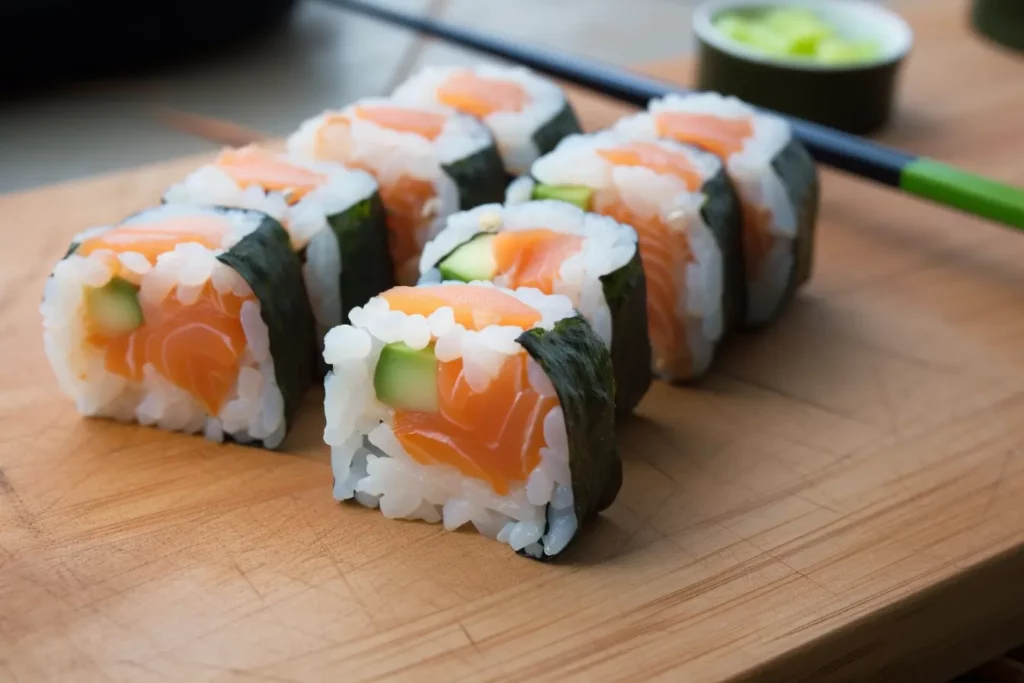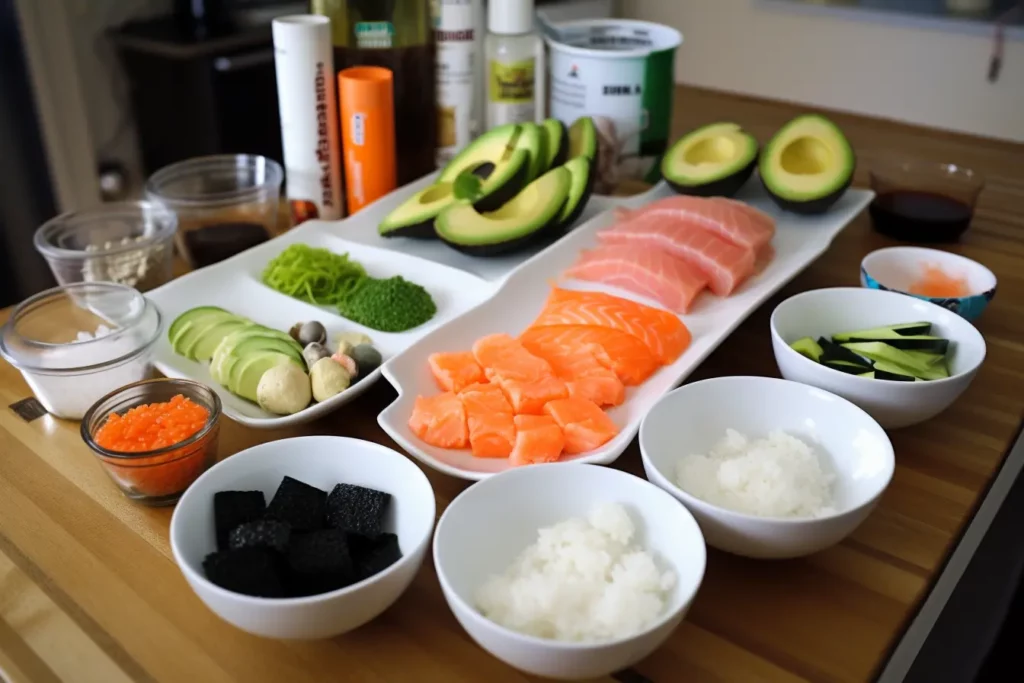The fascinating art of sushi decorating is a skill that requires both precision and creativity. It covers the basics of learning how to use traditional ingredients like nori and sashimi, and goes far beyond rolling and slicing sushi. In this essay, the focus will be on the various techniques and tools that are used in sushi decoration. It covers both the basic aspects that every sushi lover should be aware of, as well as advanced methods that require greater ingenuity and more detailed handling.
Basics of Sushi Decorating
Title: The Art of Sushi Decorating: A Stylish Guide to Perfecting This Culinary Beauty
Sushi is much more than just a meal – it’s a form of art. It is a fusion of colors, textures and flavors, all arranged in perfect harmony. But the enjoyment of sushi is not limited to the taste. It’s also about how it’s presented and decorated. Here are the basics of sushi decorating to achieve that stunning aesthetic.
First Step: Arranging
Just as important as the color and texture of the sushi ingredients is the way they are arranged. Think of your sushi roll as a canvas. You can experiment with different patterns and designs: diagonal stripes, layered waves, or even geometric formations. The main thing is that it remains visually appealing.
Step Two: Color Harmony
The color combination is key to creating a seductive sushi dish. The combination of raw fish in salmon colors, white rice, and green avocado can make for a picturesque ensemble. You should also think about contrast: a touch of dark seaweed or black sesame seeds can create a dramatic effect.
Step Three: Garnish
The highlight of any sushi presentation is the garnish. Whether it’s finely chopped leeks, sesame seeds or tiny caviar balls, anything goes. The idea is to use these elements in such a way that they not only add color and texture, but also complement the entire dish.
Final Step: The Presentation
Finally, there is the presentation. This is where the tableware plays an essential role. One should choose bowls and platters that complement the look of the sushi without distracting from it. A minimalist approach often works best here. Also, the placement of the soy sauce, wasabi and pickled ginger should be carefully considered so as not to disturb the overall picture.
In the world of sushi decorating, there are hardly any limits to creativity. It’s a blend of artistry, sense of style and passion – and that’s what makes it so fascinating. Immerse yourself in this process and discover your own sushi aesthetic. With time and practice, anyone can create the perfect, Instagram-worthy sushi.

Advanced Sushi Decorating Techniques
Perception from eye to fork
Food isn’t just a matter of taste, it’s also a visual delight. This is also the case with sushi, where the visual representation is just as important as the actual enjoyment. This Japanese art form requires attention to detail and a critical eye. To raise the level of your sushi decoration, one should take into account two important aspects – visual balance and composition.
Maintain visual balance
Achieving the visual balance of your sushi arrangements should always be a top priority. When depicting sushi, you should create a visual dynamic that balances the colors, textures, and shapes of the ingredients. Mix bright, contrasting colors with more subtle tones to create dynamism. play with the proportions of fish, rice, and other ingredients in the sushi rolls to create contrasts and balance.
The Cherry Blossom Roll is a good example of this. With its light pink salmon pieces, dark green avocado slices, and white rice, it creates a visual harmony that is both appealing and flavorful.
Composition is key
Composition is another essential part of sushi decoration. Remember that the eye of the beholder must absorb the visual elements of your sushi plate. It is therefore important that the ingredients and accessories are arranged in a clear and coherent way. You should not just randomly sprinkle the components on the plate, but consciously pay attention to how you can best arrange them.
Take the California Roll as an example. Its circular arrangement resembles a wheel or flower, with the crab meat pieces and avocado slices creating radial patterns. Not only does this create an aesthetically pleasing harmony, but it also makes it easier for guests to share and eat the dish.
Amp up your sushi style
Last but not least, let your creativity and personal style shine through your sushi arrangements. Be inspired by other art forms, be it painting, sculpture or architecture. Experiment with different shapes and sizes and express your artistic personality through the presentation of your sushi dishes.
They are crucial for your sushi decoration. And while striving for perfection is a laudable goal, that doesn’t mean you should focus too much on the small details. Rather, it’s about the overall appearance of your sushi dish, how all the components fit together to create a unique and aesthetically pleasing image. Enjoy your meal!

Individual style in sushi decorating
In order to further develop an individual style in sushi decorating, an essential question first arises: How do you want to be seen in the viewing of readers? A shocking minimalist? A colorful maximist? Or do we imagine commuting somewhere in between? The answer to this will help establish a unique visual language that will be expressed on sushi platters.
Next, the visual meaning of food really trickles in here. Food is not only a matter of taste, it is also a feast for the eyes. This is especially the case with sushi, where every roll, every slice, every garnish can be a work of art. The ability to achieve the perfect balance of shape, color, and texture can really make a sushi display stand out.
Consider, for example, the Cherry Blossom Roll. It combines delicate pink tones of fresh salmon with hints of green in the form of avocado and cucumber. All these elements are presented harmoniously to create a visually appealing dish. In addition, there is a careful selection of dishes and accessories that can enhance the aesthetics of the dish.
Composition also plays a crucial role in sushi decoration. It’s about creating a clear and coherent arrangement of ingredients and accessories. A California roll, for example, might be presented with a symmetrical arrangement of strips of crab meat in the middle, surrounded by avocado and cucumber. To this, a handmade soy husk and a small tuft of wasabi could serve as complementary elements.
And finally, experimenting with different sources of inspiration should not be overlooked. Maybe you can incorporate color schemes from fashion, texture elements from architecture, or shape ideas from the visual arts. It’s your personal interpretation of what’s aesthetically pleasing that will make your sushi presentation unique.
The expressiveness of creativity and personal style is therefore of central importance. Ultimately, it is the emphasis on the overall appearance and aesthetic impression of the sushi dish that sticks in the viewer’s memory. It’s not just about the role of the sushi itself, it’s about showcasing the entire experience that your original art form has embraced.
Thus, sushi decorating becomes more than just a technical skill – it becomes an expression of you and your world. It’s a way of expressing yourself through a medium as old as humanity itself: food. So real, so immediate, so deeply human. Make it meaningful, make it unique, make it your own… when decorating sushi.

Aesthetics and enjoyment go hand in hand, and this is especially evident when it comes to sushi decorating. By learning the basic as well as advanced techniques of sushi decoration, one has the opportunity to create a culinary experience that is extremely satisfying for both the eye and the palate. By combining techniques and ingredients, you can develop an individual style that adds a personal touch to the sushi. Unleash your creativity and create works of art that look too good to eat – but too delicious to pass up!


